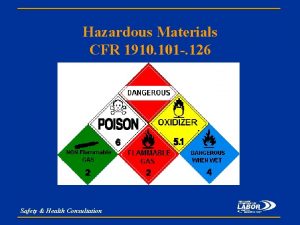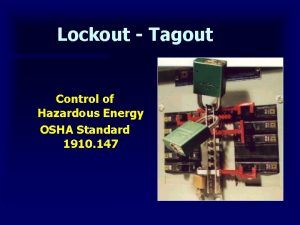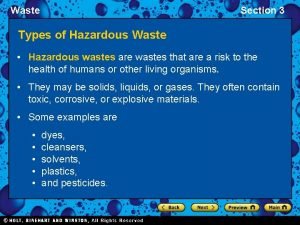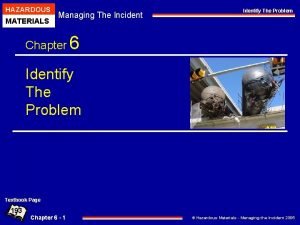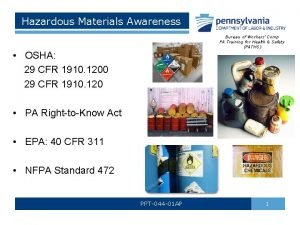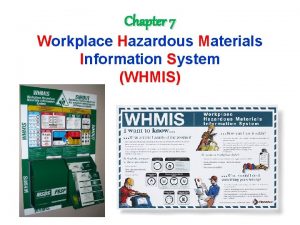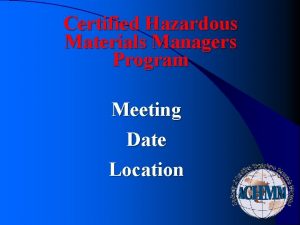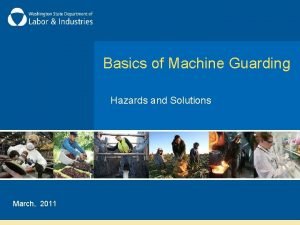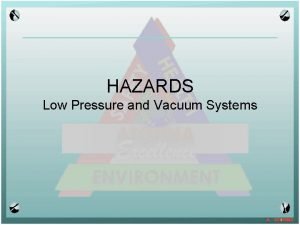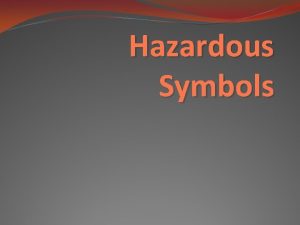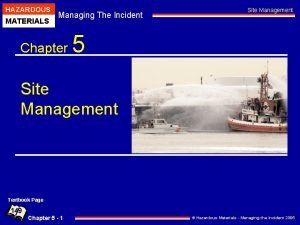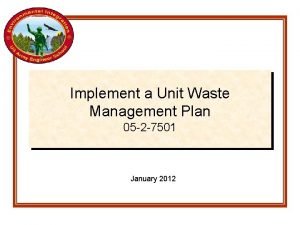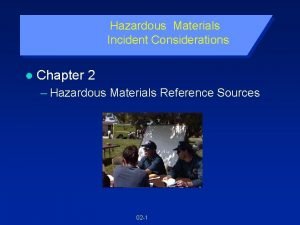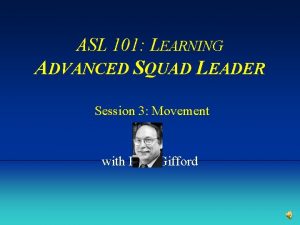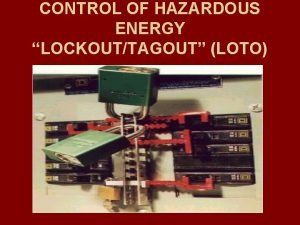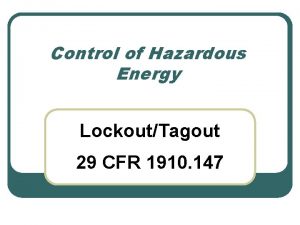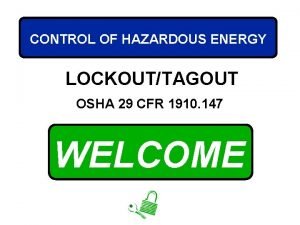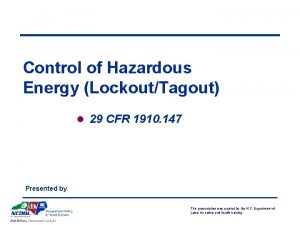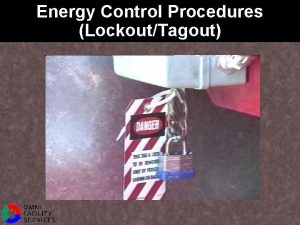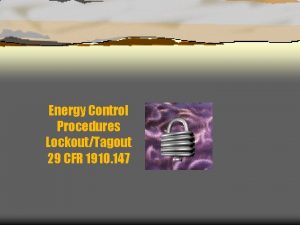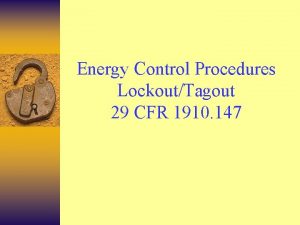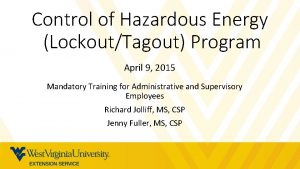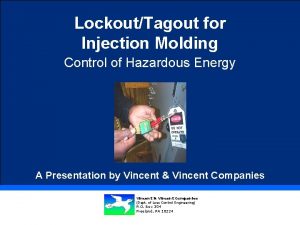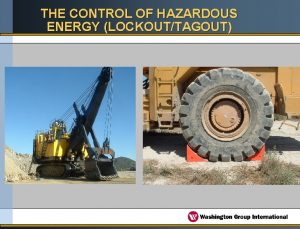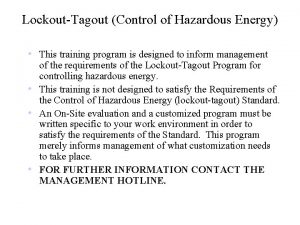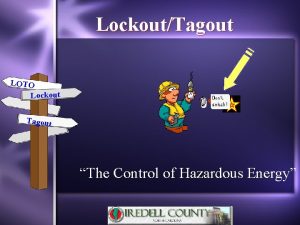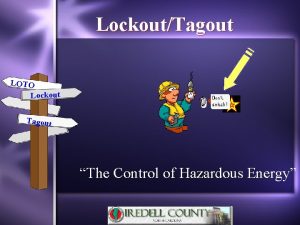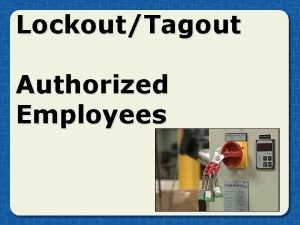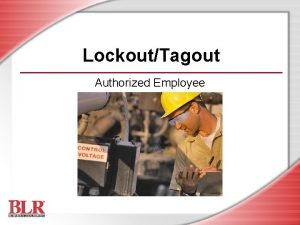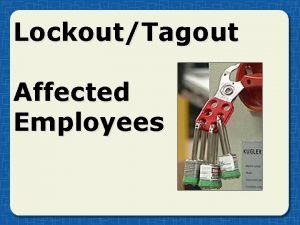LOCKOUTTAGOUT n Control of Hazardous Energy 29 CFR


































- Slides: 34


LOCKOUT/TAGOUT n Control of Hazardous Energy 29 CFR 1910. 147

Training Outline Lockout/Tagout Basics? Regulatory requirements Energy Isolation Devices Energy Sources Affected, Authorized and Other Employees Safe Work Practice Requirements

What Is Lockout/Tagout? Referred to as LOTO Provides means of warning (tag) and securement (lock) Prevents the flow or release of stored energy

Regulatory Requirements Covers operators, others and service personnel Requires initial training of involved employees Require machine specific procedures and training

Types of Lockout Devices Locks Blocks Chains / Cables Multilock hasps OS&Y valve covers Ball valve covers Cylinder caps

Requirements for Lockout/Tagout Devices They must be: Durable Standardized Substantial Identifiable

Potential Energy Sources Electricity Hydraulic Pneumatic Steam Thermal Chemical Gravity

Typical Equipment Requiring LOTO of Multiple Energy Sources Pumps Air Compressors Power Presses Motor Controllers Mixers Trash compactors Boilers Conveyors Robotics Forklifts

When Must LOTO Be Used? When servicing or maintaining equipment where: Hazardous energy exists Unexpected start-up could occur Either of these could harm an employee

LOTO Shall Always Be Used When: Employees are required to remove or bypass a safety device Employees are required to place any part of their body in harm’s way Employees are exposed to stored hazardous energy when performing service or maintenance. The electrical equipment is not cord and plug

LOTO Exceptions Work where hazardous energy does not exist Work on cord-controlled devices Hot tap operations where shutdown is not feasible While these exemptions are allowed by the OSHA Standard it is never truly advisable to forego LOTO procedures and devices.

Typical LOTO Procedures Notification of employees Performing the shutdown Isolating equipment or processes Safely releasing or controlling all stored energy by applying LOTO devices or positioning • Verify ZERO energy state of all sources Backing out of the LOTO procedure at task completion

Authorized Employee(s) Maintains equipment Services equipment Is trained to use LOTO

Affected Employees who: Operate Work around Perform minor adjustments to equipment that is subject to LOTO Note: These employees are not allowed to apply or remove LOTO devices.

Other Employees that may enter the work area during LOTO operations Must be trained concerning the purpose Must be able to recognize LOTO activities This awareness level of training is less than that of affected employees provided they understand the purpose of the procedure.

Departmental Responsibilities Ensure ability to de-energize equipment Ensure employee awareness Provide appropriate levels of training Provide appropriate LOTO devices and PPE Review program effectiveness Maintain and revise program as warranted Administer appropriate disciplinary actions

Maintenance Supervision Responsibilities Authorize Lockout/Tagout prior to service or repair Remove or cut locks off isolation devices (extreme) Ensure reliable training and evaluation of their authorized employee’s abilities to perform specific LOTO procedures

Authorized Employee Responsibilities Repair or service equipment as needed Notify affected employees when a lockout event will be taking place. Take equipment to a ZERO energy state Test equipment to verify residual energy is dissipated and that no re-accumulation will occur Place a “Danger—Do Not Operate” tag on equipment and insure all energy sources are locked out

Authorized Employee Responsibilities (cont. ) Obtain assistance when necessary Remove all tools Back out of LOTO procedure Notify affected employees when a lockout event is over

Affected Employee Responsibilities Notify maintenance, etc. , when equipment needs repair or adjustment Leave all LOTO devices in place Follow all safety rules while operating the equipment Never attempt to start or re-energize equipment or processes during a LOTO event

Other Employee Responsibility Stay clear of LOTO activities Minimize time spent in the area Never attempt to start, re-energize equipment or processes

Employee Training Requirements Authorized and Affected— Initially Authorized and Affected—whenever changes are made to jobs or procedures Authorized and Affected—when program or work practice deficiencies are noted Other—Initially or when assigned to areas where LOTO is performed

Lockout involving multiple workers Each employee should have their own devices on the equipment that they will be working on. Each employee signs out and uses his assigned lock(s). Group lockouts can be used when there are multiple employees/contractors working on equipment that has one or more power sources. When a lockout box is used, only one employee shall be designated and assigned the actual LOTO task. No LOTO box will be opened until all workers have signed off and removed their lock on the completion of the work.

Energy Source 1 Energy Source 2 EQUIPMENT Energy Source 3 Energy Source 4 How many locks are required?

Energy Source 1 Energy Source 2 EQUIPMENT Energy Source 3 Energy Source 4 How many locks are required?

How to Perform LOTO Safely Develop and follow written procedures for LOTO Refer to procedures on how to lockout specific equipment (Are they accurate? ) Keep everyone informed when equipment is under repair or being serviced Should equipment need to be jogged into position, back out of LOTO, reposition, and return sources to a continuous zero energy state before going forward.

ARE YOU TUNED IN? If you have questions please contact the City of Burlington, Director of Safety (336) 513 -5463

QUESTIONS 1. 2. 3. 4. 5. Applying locks and tags in the appropriate place ensures that a piece of equipment is properly de-energized. T/F City of Burlington employees may only use locks designated as “lockout” locks to lock out equipment. T/F You should attempt to start a piece of equipment after it has been locked out to ensure that it will not start. T/F Lockout / Tagout ONLY applies to electrical energy sources. T/F If a safety device is removed from a piece of equipment, LOTO is not required. T/F

Questions (cont. ) 6. Typical energy sources found on equipment include: _______, and _______. (there are more than 3) 7. Affected employees are those who operate or work around a piece of equipment. T/F 8. As long as an employee has had training on LOTO, the employer or company has no additional responsibilities under 1910. 147. T/F 9. Employees whose job assignments or equipment changes must be retrained. T/F 10. Locks should always stay on the equipment during a shift change. T/F

Questions (cont. ) 11. Authorized employees who understand the Lockout / Tagout program are allowed to work on energized equipment. T/F 12. Tags can be used in place of locks if locks cannot be easily applied. T/F

Answers 1. True. It should block the flow of energy and provide a means of warning. 2. Types of LOTO devices include locks, blocks, chains, hasps, wheel valve covers, and ball valve covers. 3. False. If lockout is required, a company must have a written program and procedures. 4. An authorized employee is one who services or maintains the equipment. 5. False. LOTO is required when a safety device is removed, an employee is in harms way, or when employees are exposed to hazardous energy.

Answers (cont. ) 6. Typical energy sources include: electricity, hydraulics, pneumatics, steam, thermal, chemical, and gravity. 7. True. Affected employees are those who operate or work around the equipment. 8. False. Training is just one of the responsibilities of a company. 9. True. Retraining must occur when there is a change in jobs or procedures or program deficiencies are noted. 10. False. Locks should be removed during a shift change and the shift coming on duty should place their locks on the equipment.

Answers (cont. ) 11. False. The purpose of lockout / tagout program is so that employees can work on DE-ENERGIZED equipment. 12. False. Tags should not be used in place of locks BUT should ALWAYS be used in conjunction with locks.
 Compressed gas association pamphlet p-1-1965
Compressed gas association pamphlet p-1-1965 Tagout
Tagout Energy energy transfer and general energy analysis
Energy energy transfer and general energy analysis Energy energy transfer and general energy analysis
Energy energy transfer and general energy analysis Section 3 hazardous waste answers
Section 3 hazardous waste answers Aviation hazardous attitudes
Aviation hazardous attitudes Hospital waste management introduction
Hospital waste management introduction Hazmat material table
Hazmat material table Hazardous materials table
Hazardous materials table Hazardous
Hazardous Hazwoper
Hazwoper Five hazardous attitudes
Five hazardous attitudes Avhf
Avhf Workplace hazardous materials information system (whmis)
Workplace hazardous materials information system (whmis) Chmm accreditation training
Chmm accreditation training Transverse motion machines
Transverse motion machines Msw apes
Msw apes Hazardous waste examples
Hazardous waste examples Stanislaus county hazardous waste
Stanislaus county hazardous waste Nj crtk environmental hazardous substances
Nj crtk environmental hazardous substances Vacuum hazards
Vacuum hazards Hazardous materials transportation act of 1975
Hazardous materials transportation act of 1975 Hazardous area training darwin
Hazardous area training darwin Hazardous symbols
Hazardous symbols Hazardous materials managing the incident
Hazardous materials managing the incident Keeping food safe chapter 1
Keeping food safe chapter 1 Hazardous drug api
Hazardous drug api On july 18 2001 a train carrying hazardous chemicals
On july 18 2001 a train carrying hazardous chemicals Waste management references
Waste management references Hazardous materials reference books
Hazardous materials reference books Hazardous area response team
Hazardous area response team Hazardous movement asl
Hazardous movement asl Solid and hazardous waste
Solid and hazardous waste Pipeline and hazardous materials administration
Pipeline and hazardous materials administration Noaa experimental forecast
Noaa experimental forecast
